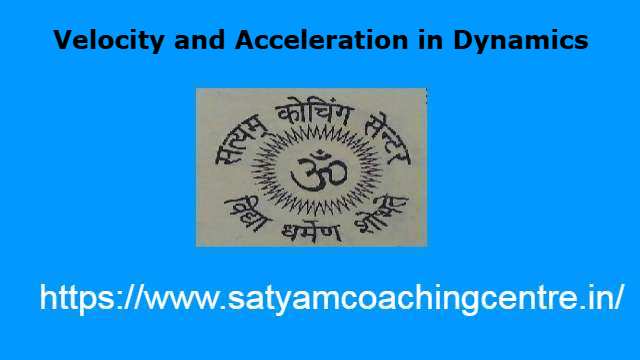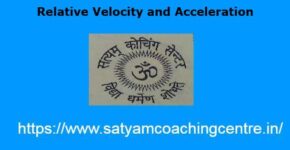Velocity and Acceleration in Dynamics
1.गति विज्ञान में वेग एवं त्वरण (Velocity and Acceleration in Dynamics),वेग एवं त्वरण (Velocity and Acceleration):
गति विज्ञान में वेग एवं त्वरण (Velocity and Acceleration in Dynamics) के इस आर्टिकल में वेग एवं त्वरण से सम्बन्धित सवालों को हल करके समझने का प्रयास करेंगे।
आपको यह जानकारी रोचक व ज्ञानवर्धक लगे तो अपने मित्रों के साथ इस गणित के आर्टिकल को शेयर करें।यदि आप इस वेबसाइट पर पहली बार आए हैं तो वेबसाइट को फॉलो करें और ईमेल सब्सक्रिप्शन को भी फॉलो करें।जिससे नए आर्टिकल का नोटिफिकेशन आपको मिल सके।यदि आर्टिकल पसन्द आए तो अपने मित्रों के साथ शेयर और लाईक करें जिससे वे भी लाभ उठाए।आपकी कोई समस्या हो या कोई सुझाव देना चाहते हैं तो कमेंट करके बताएं।इस आर्टिकल को पूरा पढ़ें।
Also Read This Article:- Vertical Motion Under Gravity
2.गति विज्ञान में वेग एवं त्वरण साधित उदाहरण (Velocity and Acceleration in Dynamics Solved Examples):
Example:1(a).यदि कोई कण एक सरल रेखा में चले और उसकी गति x^2=a t^2+2 b t+c द्वारा दी जाये,तो सिद्ध करो कि उसका त्वरण x^3 के व्युत्क्रमानुपाती होगा।
(If a particle moving along a straight line and its velocity is given by x^2=a t^2+2 b t+c ,then prove that the acceleration is inversely proportional to x^3 .)
Solution: x^2=a t^2+2 b t+c \\ a t^2+2 b t+c-x^2=0 \\ t=\frac{-2 b \pm \sqrt{(2 b)^2-4 a\left(c-x^2\right)}}{2 a} \\ =\frac{-2 b \pm \sqrt{4 b^2-4 a c+4 a x^2}}{2 a} \\ =\frac{-2 b}{2 a} \pm \frac{2 \sqrt{b^2-a c+a x^2}}{2 a} \\ \Rightarrow t=-\frac{b}{a} \pm \frac{\sqrt{b^2-a c+a x^2}}{a}
t के सापेक्ष अवकलन करने परः
1=0 \pm \frac{1}{a} \cdot \frac{1}{2 \sqrt{b^2-a c+a x^2}} \cdot 2ax \frac{d x}{d t} \\ \Rightarrow \frac{d x}{d t}= \pm \frac{\sqrt{b^2-a c+a x^2}}{x} \cdots(1)
पुनः t के सापेक्ष अवकलन करने परः
\frac{d^2x}{dt^2}=\pm \frac{d}{d x} \frac{\sqrt{b^2-a c+a x^2}}{x} \\ = \pm \frac{d}{d x} \left(\frac{\sqrt{b^2-a c+a x^2}}{x}\right) \frac{d x}{d t} \\ =\pm \frac{x \cdot \frac{d}{x}\left(\sqrt{b^2-a c+a x^2}\right)-\sqrt{b^2-a c+a x^2}\cdot 1}{x^2} \frac{d x}{d t} \\ =\pm \frac{x \cdot \frac{1}{2 \sqrt{b^2-a c+a x^2}} \times 2 a x-\sqrt{b^2-ac+a x^2}}{x^2} \frac{d x}{d t} \\ =\pm \frac{\frac{a x^2}{\sqrt{b^2-a c+a x^2}}-\sqrt{b^2-a c+a x^2}}{x^2} \frac{d x}{d t} \\ = \pm \frac{a x^2-\left(b^2-a c+a x^2\right)}{x^2 \sqrt{b^2-a c+a x^2}} \times \pm \frac{\sqrt{b^2-a c+a x^2}}{x} \\ =\frac{a x^2-b^2+a c-a x^2}{x^3} \\ \Rightarrow \frac{d^2 x}{d t^2}=\frac{-b^2+a c}{x^3} \\ \Rightarrow \frac{d^2 x}{d t^2} \propto \frac{1}{x^3}
Example:1(b).यदि सरल रेखा में गतिमान किसी कण द्वारा t सेकण्ड में चली दूरी x=2 t^3-9 t^2+12 t+6 मीटर हो,तो ज्ञात कीजिए कि उसका त्वरण शून्य कब होगा और उस समय उसका वेग क्या होगा?
(If the distance travelled by a particle along a straight line in time t sec. is x=2 t^3-9 t^2+12 t+6 meter,find when its acceleration will be zero and what will be its velocity at that time?)
Solution: x=2 t^3-9 t^2+12 t+6
t के सापेक्ष अवकलन करने परः
\frac{d x}{d t}=6 t^2-18 t+12
पुनः t के सापेक्ष अवकलन करने परः
\frac{d^2 x}{d t^2}=12 t-18
त्वरण शून्य होगा यदि \frac{d^2 x}{d t^2}=0 \\ 12 t-18=0 \Rightarrow 12 t=18 \\ t=\frac{18}{12}=\frac{3}{2} सेकण्ड
अतः t=\frac{3}{2} सेकण्ड पश्चात त्वरण शून्य होगा तथा उस समय वेग होगा:
\frac{d x}{d t}=6 \times\left(\frac{3}{2}\right)^2-18 \times \frac{3}{2}+12 [(1) से]
=6 \times \frac{9}{4}-27+12 \\ =\frac{27}{2}-27+12 \\ =\frac{27}{2}-\frac{15}{1}=\frac{27-30}{2} \\ \Rightarrow \frac{d x}{d t}=-\frac{3}{2} मीटर/सेकण्ड
Example:2.सरल रेखा में गतिमान किसी कण का वेग,सम्बन्ध v^2=a x^2+a^2 b x+c से दिया जाता है।सिद्ध करो कि उसका त्वरण,रेखा पर स्थित किसी बिन्दु से दूरी के समानुपाती होगा।
(The velocity of a particle moving along a straight line is given by the relation v^2=a x^2+a^2 b x+c .Prove that the acceleration varies as the distance from a fixed point in the line.)
Solution: v^2=a x^2+a^2 b x+c\\ \Rightarrow v=\sqrt{a x^2+2 b x+c}
x के सापेक्ष अवकलन करने परः
\Rightarrow \frac{d v}{d x}=\frac{a x+b}{\sqrt{a x^2+2 b x+c}} \\ \Rightarrow\left(\sqrt{a x^2+2 b x+c}\right) \frac{d v}{d x}=a x+b \\ \Rightarrow v \frac{d v}{d x}=a x+b
\Rightarrow त्वरण v \frac{d v}{d x}=a x+b
Example:3.एक कण सरल रेखा में इस प्रकार चलता है कि रेखा पर स्थित किसी स्थिर बिन्दु से किसी समय उसकी दूरी x और वहाँ पर कण का वेग v का सम्बन्ध v^2=\mu\left(a^2-x^2\right) से दिया जाता है।सिद्ध करो कि उसका त्वरण मूल बिन्दु से कण की दूरी के समानुपाती और मूल बिन्दु की ओर होगा।
(A particle moves along a straight line such that its distance x from a fixed point on it and the velocity v are related v^2=\mu\left(a^2-x^2\right). Prove that the acceleration varies as the distance of the particle from the origin and is directed towards the origin.)
Solution: v^2=\mu\left(a^2-x^2\right) \\ \Rightarrow v =\sqrt{\mu\left(a^2-x^2\right)}
x के सापेक्ष अवकलन करने पर:
\frac{d v}{d x}=\frac{\sqrt{\mu}}{2 \sqrt{\left(-a^2-x^2\right)}} \cdot(-2 x) \\ \Rightarrow \sqrt{a^2-x^2}\left(\frac{d v}{d x}\right)=-\sqrt{\mu} x \\ \Rightarrow \sqrt{\mu\left(a^2-x^2\right)}\left(\frac{d v}{d x}\right)=-\mu x \\ \Rightarrow v \frac{d v}{d x}=-\mu x
त्वरण v \frac{d v}{d x} \propto(-x)
ऋणात्मक चिन्ह प्रदर्शित करता है कि त्वरण मूल बिन्दु की ओर है।
Example:4.यदि समय t को वेग v का फलन मानें,तो सिद्ध करो कि f त्वरण के घटने की दर f^3 \frac{d^2 t}{d v^2} द्वारा दी जाती है।
(If time t be regarded as a function of velocity,prove that the rate of decrease of acceleration f is given by f^3 \frac{d^2 t}{d v^2} .)
Solution:त्वरण के घटने की दर=-\frac{d f}{d t}
माना t=F(v)
t के सापेक्ष अवकलन करने परः
1=F^{\prime}(v) \frac{d v}{d t} \\ \Rightarrow \frac{d t}{d v}=F^{\prime}(v) \\ \Rightarrow f=\frac{d v}{d t}=\frac{1}{F^{\prime}(v)} \cdots(1)
पुनः अवकलन करने परः
\frac{d f}{d t}=-\frac{F^{\prime \prime}(v)}{\left[F^{\prime}(v)\right]^2} \frac{d v}{d t} \\ \frac{d f}{d t}=-\frac{F^{\prime \prime}(v)}{\left[F^{\prime}(v)\right]^3} \\ \Rightarrow \frac{d f}{d t}=-F^{\prime \prime}(v) f^3 \cdots(2)
पुनः (1) सेः
\frac{d t}{d v}=F^{\prime}(v)
v के सापेक्ष अवकलन करने परः
\Rightarrow \frac{d^2 v}{d t^2}=F^{\prime \prime}(v) \cdots(3)
(2) व (3) सेः
\Rightarrow \frac{d^2 v}{d t^2}=-\left(\frac{d f}{d t}\right) \frac{1}{\left(f^3\right)} \\ \Rightarrow-\frac{d f}{d t}=f^3 \frac{d^2 v}{d t^2}
Example:5.सरल रेखा में चल रहे किसी कण की मूल बिन्दु से दूरी x पर वेग \frac{\left(a^2-x^2\right)^{\frac{1}{2}}}{x^2} के समानुपाती है।इसके त्वरण का नियम ज्ञात कीजिए।
(The velocity of a particle moving along a straight line,when at a distance x from the origin varies as \frac{\left(a^2-x^2\right)^{\frac{1}{2}}}{x^2} .Find the law of acceleration.)
Solution:प्रश्नानुसार v \propto \frac{\left(a^2-x^2\right)^{\frac{1}{2}}}{x^2}\\ \Rightarrow v=k \frac{\left(a^2-x^2\right)^{\frac{1}{2}}}{x^2}
x के सापेक्ष अवकलन करने परः
\frac{d v}{d x}=k\left[\frac{x^2 \cdot \frac{d}{d x}\left(a^2-x^2\right)^{\frac{1}{2}}-\sqrt{a^2-x^2} \cdot 2 x}{x^4}\right] \\ =k\left[\frac{x^2 \cdot \frac{-2 x}{2 \sqrt{a^2-x^2}}-\sqrt{a^2-x^2}\cdot 2 x}{x^4}\right] \\ =-k\left[\frac{x^3+2\left(a^2-x^2\right) \cdot x}{x^4 \sqrt{a^2-x^2}}\right] \\ =-k\left[\frac{x^3+2 a^2 x-2 x^3}{x^4 \sqrt{a^2-x^2}}\right] \\ =-k\left(\frac{2a^2 x-x^3}{x^4 \sqrt{a^2-x^2}}\right) \\=-\frac{k\left(2a^2-x^2\right) x}{x^4 \sqrt{a^2-x^2}} \\ \Rightarrow\left(\sqrt{a^2-x^2}\right) \frac{d v}{d x}=-\frac{k\left(2a^2-x^2\right)}{x^3} \\ \Rightarrow \frac{\sqrt{a^2-x^2}}{x^2}\left(\frac{d v}{d x}\right)=\frac{-k\left(2 a^2-x^2\right)}{x^5} \\ \Rightarrow v \frac{d v}{d x}=-k\left(\frac{2 a^2}{x^5}-\frac{1}{x^3}\right) \\ \Rightarrow f=v \frac{d v}{d x}=-k\left(\frac{2 a^2}{x^5}-\frac{1}{x^3}\right) \\ \Rightarrow f \propto\left(\frac{2 a^2}{x^5}-\frac{1}{x^3}\right)
Example:6.यदि सरल रेखा में गति का नियम x=\frac{1}{2} v t हो तो सिद्ध कीजिए कि त्वरण अचर होगा।
(If the law of motion in a straight line is x=\frac{1}{2} v t then prove that the acceleration is constants.)
Solution: x=\frac{1}{2} v t
t के सापेक्ष अवकलन करने परः
\frac{d x}{d t}=\frac{1}{2} v+\frac{1}{2} t \frac{d v}{d t} \\ \frac{d x}{d t}=v तथा \frac{d v}{d t}=f रखने परः
\Rightarrow v=\frac{1}{2} v+\frac{1}{2} t f \\ \Rightarrow \frac{1}{2} v=\frac{1}{2} f t \\ \Rightarrow v=f t
पुनः t के सापेक्ष अवकलन करने परः
\frac{d v}{d t}=f+\dot{f} t \\ \Rightarrow \dot{f} t=0 \\ \Rightarrow \dot{f}=0 \\ \Rightarrow f=\text { constant }
उपर्युक्त उदाहरणों के द्वारा गति विज्ञान में वेग एवं त्वरण (Velocity and Acceleration in Dynamics),वेग एवं त्वरण (Velocity and Acceleration) को समझ सकते हैं।
3.गति विज्ञान में वेग एवं त्वरण के सवाल (Velocity and Acceleration in Dynamics Questions):
(1.)यदि सरल रेखा में गतिमान कण द्वारा t सेकण्ड में चली गई दूरी x=t^3-9 t^2+24 t+6 मीटर हो,तो ज्ञात कीजिए कि जब उसका त्वरण शून्य होगा तब उसकी स्थिति क्या होगी?
(If the distance travelled by a particle along a straight line in time t sec. x=t^3-9 t^2+24 t+6 meter, find when its acceleration will be zero then what will the position of the particle at that instant?)
(3.)x और y के अक्षों के समानांतर एक गतिमान बिंदु के वेग क्रमशः u+ey और v+ex हैं; दिखाएँ कि पथ एक शंकु खंड है।
(Velocities of a moving point parallel to the axes of x and y are u+ey and v+ex respectively;show that the path is a conic section.)
उत्तर (Answers):(1.)x=24 मीटर
(2.) (u+e y)^2=(v+e x)^2+c
उपर्युक्त सवालों को हल करने पर गति विज्ञान में वेग एवं त्वरण (Velocity and Acceleration in Dynamics),वेग एवं त्वरण (Velocity and Acceleration) को ठीक से समझ सकते हैं।
Also Read This Article:- Motion in Resisting Medium
4.गति विज्ञान में वेग एवं त्वरण (Velocity and Acceleration in Dynamics),वेग एवं त्वरण (Velocity and Acceleration) से सम्बन्धित अक्सर पूछे जाने वाले प्रश्न:
प्रश्न:1.वेग को परिभाषित करो। (Define Velocity):
उत्तर:किसी कण अथवा पिण्ड के विस्थापन की दर (rate of change of displacement) को उसका वेग (velocity) कहते हैं।यह एक सदिश राशि होती है।
प्रश्न:2.त्वरण को परिभाषित करो। (Define Acceleration):
उत्तर:किसी गतिशील कण के वेग परिवर्तन की दर (rate of change of velocity) को त्वरण (acceleration) कहते हैं।इसे सामान्यतः f से निरूपित किया जाता है।
प्रश्न:3.वेग एवं त्वरण के सूत्र लिखो। (Write the Formulae for Velocity and Acceleration):
उत्तर:(1.)वेग v=\frac{d x}{d t} या \frac{d s}{d t}
(2.)त्वरण f=\frac{d v}{d t}=\frac{d^2 x}{d t^2}=v \frac{d v}{d x}
उपर्युक्त प्रश्नों के उत्तर द्वारा गति विज्ञान में वेग एवं त्वरण (Velocity and Acceleration in Dynamics),वेग एवं त्वरण (Velocity and Acceleration) के बारे में और अधिक जानकारी प्राप्त कर सकते हैं।
| No. | Social Media | Url |
|---|---|---|
| 1. | click here | |
| 2. | you tube | click here |
| 3. | click here | |
| 4. | click here | |
| 5. | Facebook Page | click here |
| 6. | click here | |
| 7. | click here |
गति विज्ञान में वेग एवं त्वरण
(Velocity and Acceleration in Dynamics)
Velocity and Acceleration in Dynamics
गति विज्ञान में वेग एवं त्वरण (Velocity and Acceleration in Dynamics) के इस
आर्टिकल में वेग एवं त्वरण से सम्बन्धित सवालों को हल करके समझने का प्रयास करेंगे।







